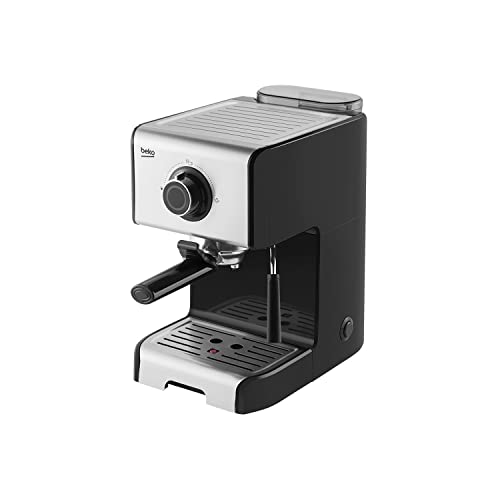Espresso Maker - A Must-Have For Home Baristas
Espresso is a dark, strong drink that is produced by pushing hot coffee through finely ground, tightly packed coffee grounds. It is the basis for many popular drinks in the café.
A barista, also known as an "espresso maker" controls a number of variables to create a perfect cup. These include the temperature of the water, the pressure of it and how tightly the coffee is packed.
Origins
The espresso maker is a machine that presses small quantities of close to boiling water under high pressure through coffee beans that have been finely ground. The espresso is stronger, more concentrated and served in smaller cups. This is a great option for those who want a strong cup of coffee but want it quickly!

The first espresso machines were invented in the 19th century. At the time, coffee was a major business, but the process of making it took too long. Impatient people everywhere were hungry for coffee in a hurry!
Angelo Moriondo of Turin patented one of the first coffee machines in 1884. Its name read "New steam machinery for the economic and instantaneous production of coffee beverage Method A. Moriondo."
automatic espresso machine and Desiderio Pavoni adapted and improved on this machine. They introduced the portafilter and numerous brewheads as well with other innovations that are still associated with espresso makers today. The Ideale was their machine and it was a hit with the crowd at the 1906 Milan Fair. Nine out of ten Italian homes have Moka Pots. Moka Pot.
Variations
Espresso is more intense in flavor than coffee. It is a great match with milk to make café favourites like lattes or cappuccinos. Its bold flavor is also evident in recipes for baked goods marinades, other dishes and more.
There are four kinds of espresso machines: semi-automatic manual lever, super-automatic, and. Each has a distinct method of creating pressure extracting the espresso.
A manual lever machine works using a mechanical piston to press water through the grounds. It's the perfect blend of manual control and mechanized consistent. You'll still have the grind, tamp, and pull shot but you can manage the temperature and pressure of water much better.
Moka pots are a different manual espresso maker, which functions similarly to a modern pump-driven espresso machine. In an airtight vessel, boiling water produces steam. This steam is transported into a basket containing ground coffee, and then through a filter made of metal into the top cup. They're less expensive than full-sized espresso machine, but they're able to only hold up to 1-1.5 bars of pressure, which is lower than the ideal for brewing espresso.
Ingredients
With a bit of time and practice espresso makers can aid baristas at home create cafe-style drinks like lattes, cappuccinos and flat whites. You can add flavored extracts or syrups to espresso shots to create drinks that are rich, like an espresso martini.
To enjoy a delicious espresso drink you'll need top-quality beans, fresh milk, and sugar. To ensure an even extraction, choose coffee beans that have a special espresso label. Make them into fine powder. You can experiment with various roasts until you discover the one you like best.
You'll also need a burr grinder that grinds the beans to a uniform texture. The espresso machine comes with a portafilter that holds the grounds, as well as a tamper. This is used to pack the coffee in a tight manner.
Finally, you'll need a set of espresso cups and a steamer, or a frother to make the silky aerated and creamy milk that is characteristic of espresso drinks. Some machines have a steam wand built in, which can make this process much easier and speedier. You'll also have to regularly remove the scale from the machine, which involves running the solution of water and vinegar through the system.
Techniques
Espresso brewing relies on creating pressure that allows for rapid extraction of intense flavors from finely ground dark-roast and dark-roast beans packed into a "puck." This method of brewing produces the strong coffee shot referred to as espresso. When made well, espresso features a luxurious crema (or dense foam) over the top.
Contrary to the Moka Express that uses heat to purify water through coarsely ground coffee most espresso makers make use of highly pressurized water that is forced through small grounds using high heat. This produces an espresso like beverage that can be diluted in water or milk to make other drinks, like lattes or cappuccinos.
The Moka Express is a cheap basic appliance. Other espresso machines, however, are more complex, expensive and come with a variety of drinks. The most well-known lever machines are Italian-designed machines that make use of a spring-loaded arm to pour hot water from the cylinder into the portafilter. The barista has the ability to alter variables like water temperature and grind size shot-by-shot to get the best results. These machines were instrumental in bringing espresso into greater prominence throughout Italy and Europe.
Equipment
An espresso machine that is good be able to extract both soluble and non-soluble solids from finely ground tightly packed coffee. This is made possible by pressure and controlled variables, like temperature and grind size. Then there's the flavor that is influenced by various factors, including the beans and the way they're handled and made.
There are various kinds of espresso machines, however the semiautomatic is the most common. It utilizes an electric pump to force the water through the grounds. It also allows the user to do the grinding and tamping. These machines tend to be the most affordable, but they're not as consistent as spring pistons or other manual designs.
The higher-end lever models have an equilibrated piston that does the work for you. They're more tolerant than spring piston machines, however they still require some expertise to use correctly. They typically require a lot of maintenance, requiring you to heat and de-assemble the portafilter as well as the piston each time.
